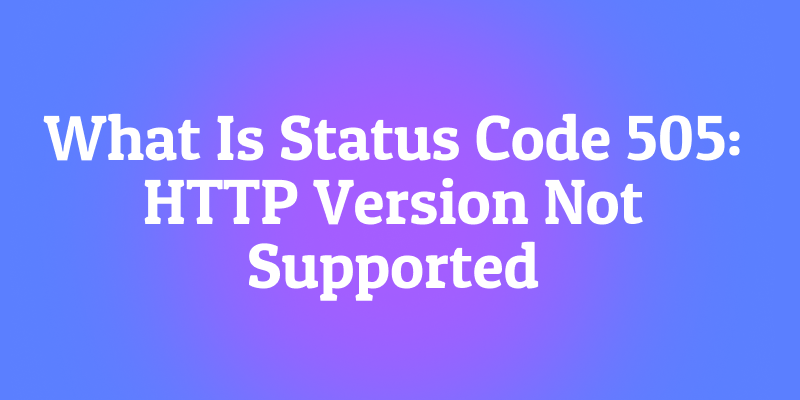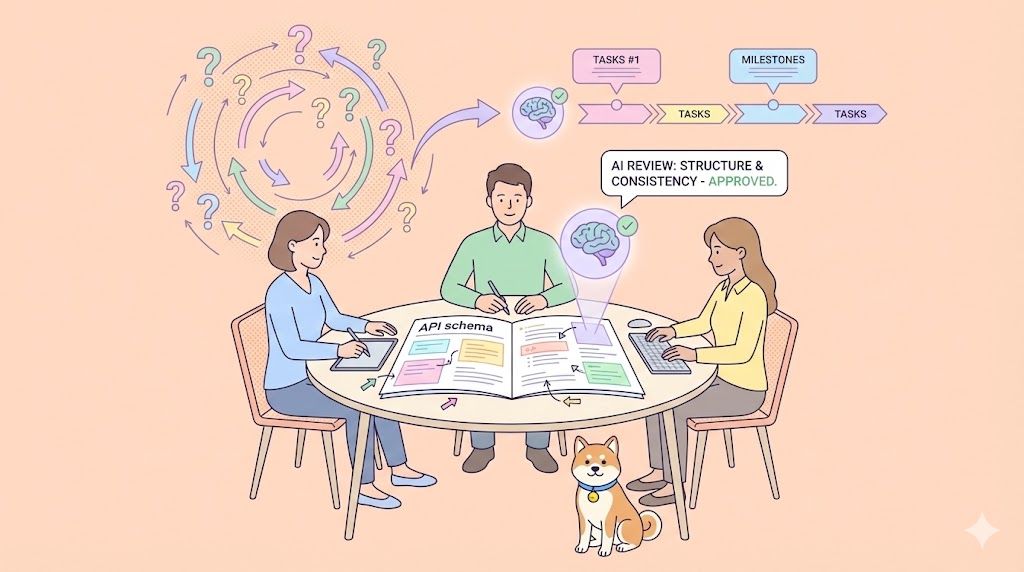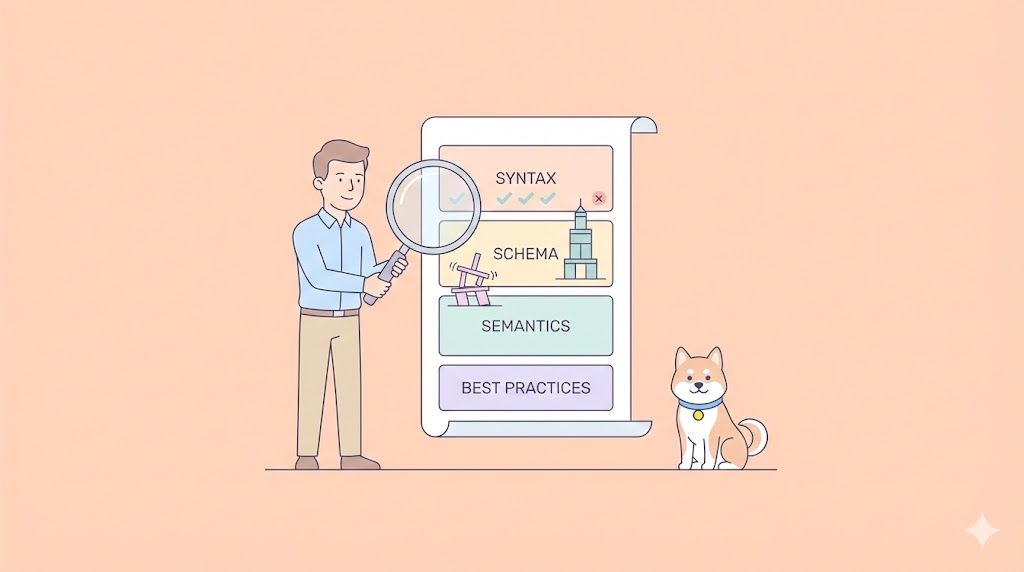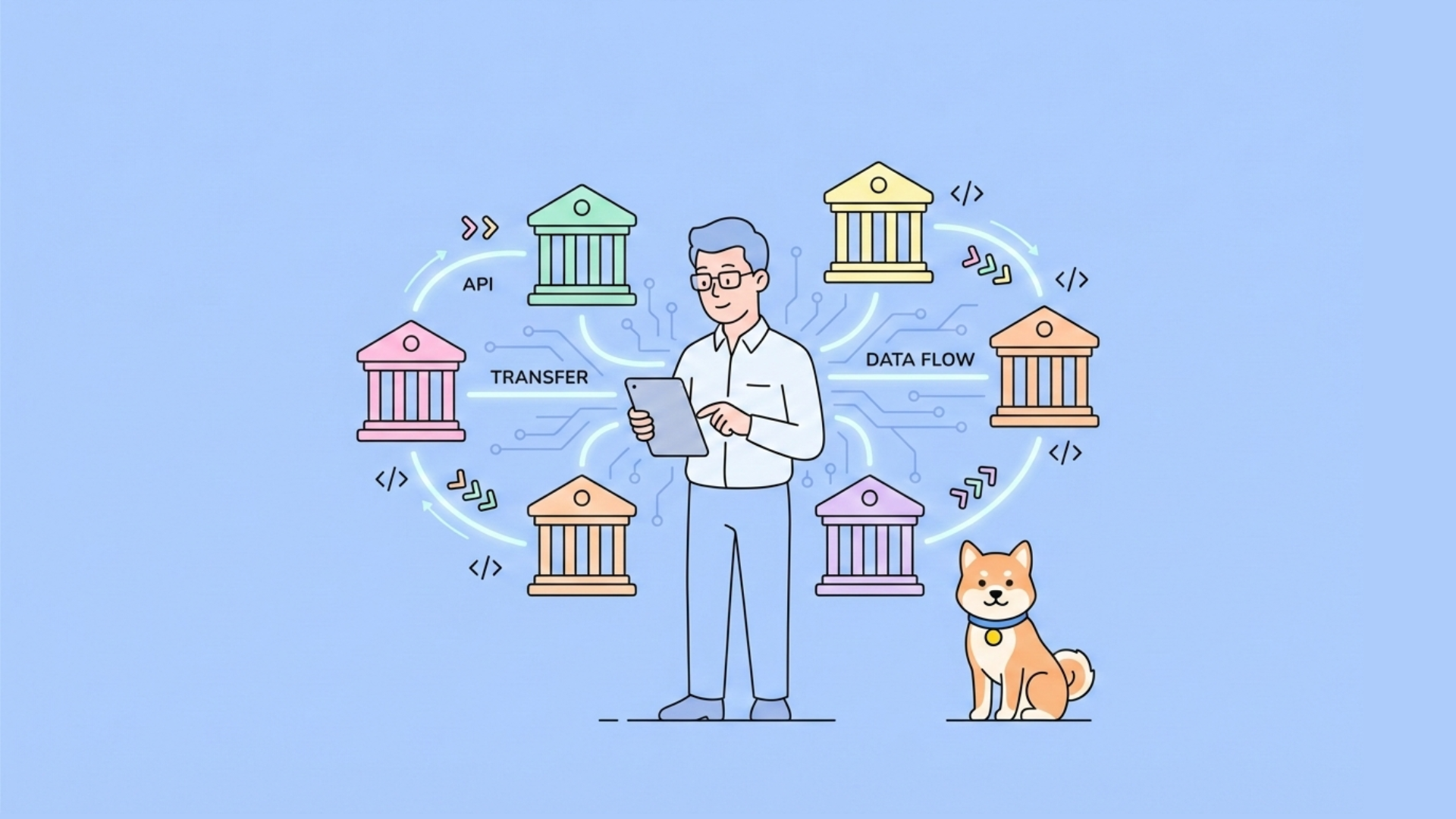You're trying out a new, cutting-edge HTTP client that uses the latest HTTP/3 protocol. You send a request to an older server, expecting a response, but instead you get back a blunt and somewhat confusing error: 505 HTTP Version Not Supported.
This status code represents a fundamental communication breakdown not at the application level, but at the very foundation of how the client and server are trying to talk to each other. It's the digital equivalent of trying to have a conversation using a language your partner doesn't understand.
While most HTTP errors are about problems with the request content or server processing, the 505 error is more fundamental. It's about the basic rules of the conversation itself. The server is essentially saying, "I don't even understand how you're trying to talk to me."
If you're a developer working with modern web technologies or maintaining legacy systems, understanding this code can save you from some confusing debugging sessions.
Before we get into the technical details, if you're building or testing APIs across different environments, you need a tool that can help you manage these protocol-level compatibility issues. Download Apidog for free; it's an all-in-one API platform that handles HTTP protocol differences seamlessly, allowing you to focus on building your application logic rather than worrying about protocol negotiations.
Now, let's explore the world of HTTP versions and what happens when they don't match up.
The Evolution of HTTP: A Brief History
To understand the 505 error, we need to understand how HTTP has evolved over time. Think of HTTP versions as different editions of a rulebook for web communication.
- HTTP/0.9 (1991): The primitive ancestor. Only supported GET requests and returned plain text.
- HTTP/1.0 (1996): Added headers, status codes, and support for different content types. This is where the web started to get sophisticated.
- HTTP/1.1 (1997): The workhorse that powered the web for decades. Added persistent connections, chunked transfers, and many optimizations we take for granted.
- HTTP/2 (2015): A major overhaul focused on performance. Introduced multiplexing, header compression, and server push.
- HTTP/3 (2022): The latest evolution, using QUIC protocol over UDP instead of TCP for even better performance, especially on mobile networks.
Most of the web today runs on HTTP/1.1, with growing adoption of HTTP/2 and HTTP/3. The 505 error occurs when there's a mismatch between what the client wants to use and what the server can handle.
What Does HTTP 505 Version Not Supported Actually Mean?
The 505 HTTP Version Not Supported status code indicates that the server does not support, or refuses to support, the major version of HTTP that was used in the request message.
The server is basically saying: "I received your request, but you're using a version of HTTP that I don't understand or won't accept. I can't process this."
A typical 505 response looks like this:
HTTP/1.1 505 HTTP Version Not SupportedContent-Type: text/htmlContent-Length: 175
<html><head><title>505 HTTP Version Not Supported</title></head><body><center><h1>505 HTTP Version Not Supported</h1></center></body></html>
Notice something interesting? The server responds using HTTP/1.1, even though it's rejecting the client's version. This is because the server needs to use a version it understands to communicate the error.
In simpler terms:
Your client (like a browser, app, or API testing tool) sends a request with an HTTP version say, HTTP/2 or HTTP/3. But the server says,
"Sorry, I only speak HTTP/1.1. Try again with that."
This status code is part of the 5xx class of server responses, which all indicate a server-side problem. However, unlike a 500 (Internal Server Error) or a 503 (Service Unavailable), a 505 doesn't necessarily mean something is broken. It's more about compatibility.
When to Expect a 505
505 errors are most common in environments where:
- Clients use legacy protocols while servers require modern versions with features like persistent connections, chunked transfer encoding, or multiplexing.
- Proxies or load balancers enforce version compatibility for security or performance reasons.
- API gateways or reverse proxies block unsupported HTTP features during protocol negotiation.
Because this is a version-compatibility issue, it often reveals deeper architectural decisions about client support and infrastructure modernization.
How the HTTP Version is Communicated
Every HTTP request starts with a "request line" that specifies the method, path, and HTTP version. Here's what that looks like for different versions:
HTTP/1.1 Request:
GET /api/users HTTP/1.1Host: example.com
HTTP/2 Request: (Actually uses a binary format, but conceptually):
:method = GET
:path = /api/users
:scheme = https
HTTP/3 Request: (Uses QUIC frames, again conceptually similar)
The server examines this initial line/frame to determine which version the client is using.
Common Scenarios That Trigger 505 Errors
1. Experimental or Custom HTTP Versions
A developer might experiment with a custom HTTP version or use an outdated experimental version that the server doesn't recognize.
GET /api/data HTTP/2.5Host: example.com
If the server only understands up to HTTP/2, it would reject this with a 505.
2. Misconfigured Clients or Servers
A client might be misconfigured to request a higher HTTP version than the server supports, or a server might be misconfigured to reject versions it should support.
3. Legacy Systems
An old server that only understands HTTP/1.0 might receive an HTTP/1.1 request and respond with 505, though most modern servers are backward compatible.
4. Protocol Upgrade Failures
During HTTP/2 or HTTP/3 negotiation, if something goes wrong in the handshake process, it might result in a 505 error.
The Reality: Why 505 Errors Are Rare
Here's the interesting thing: you'll almost never see a 505 error in the wild today. Here's why:
- Backward Compatibility: Modern web servers and clients are designed to be backward compatible. A server that supports HTTP/2 will almost always also support HTTP/1.1 requests.
- Graceful Degradation: When a client wants to use a newer protocol like HTTP/2 or HTTP/3, it typically starts with an HTTP/1.1 request and then negotiates an upgrade. If the upgrade fails, it falls back to HTTP/1.1 rather than immediately failing with a
505. - Widespread HTTP/1.1 Support: HTTP/1.1 has been the standard for so long that virtually every server on the internet supports it.
Testing Protocol Compatibility with Apidog
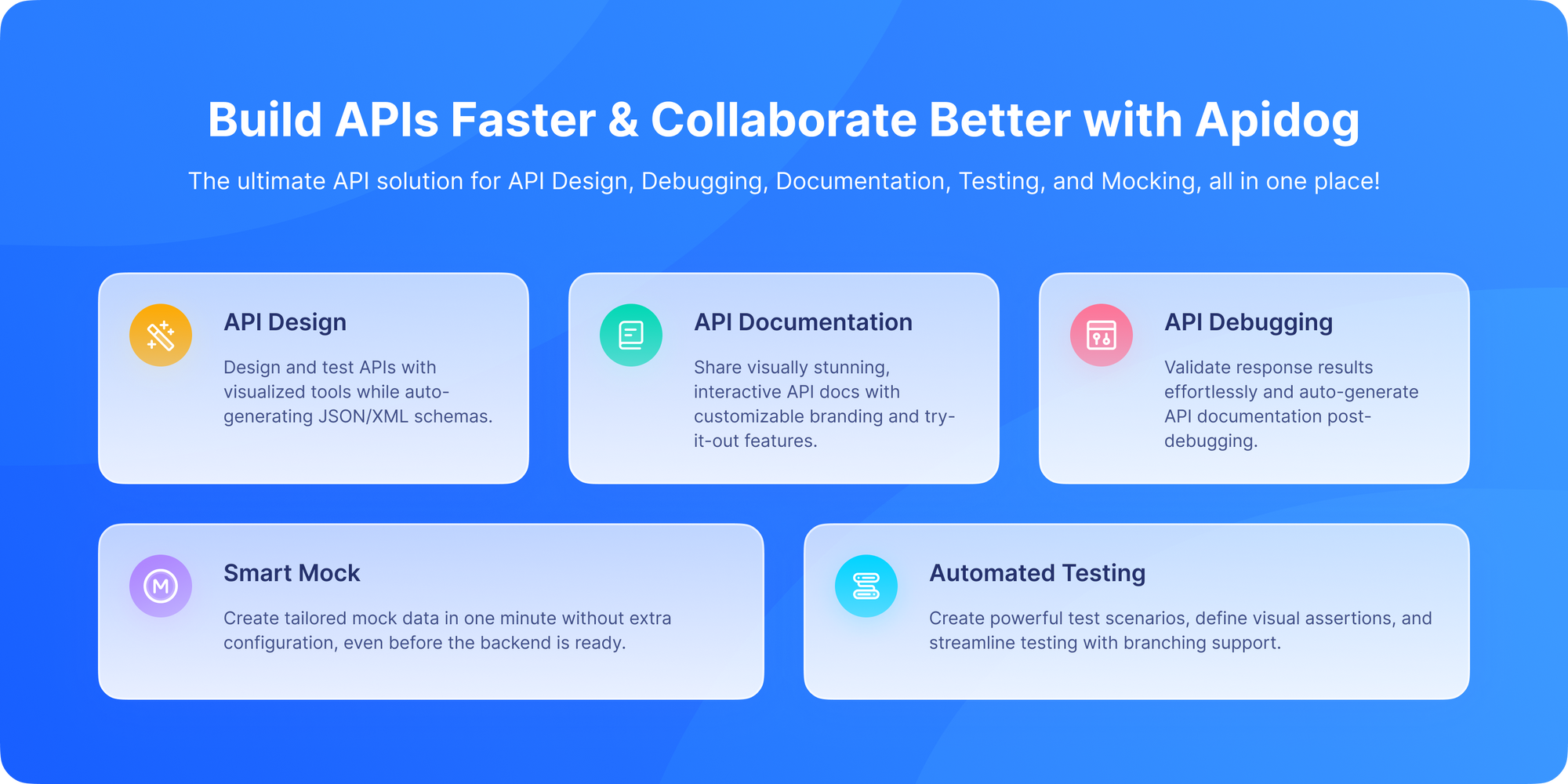
While you might not encounter 505 errors frequently, testing how your application handles different HTTP versions is still valuable. Apidog makes this process straightforward.
With Apidog, you can:
- Test Standard Requests: Ensure your API works correctly with the most common HTTP/1.1 protocol.
- Simulate Different Scenarios: Create test cases that simulate what might happen if your application encounters a server that only supports older HTTP versions.
- Validate Error Handling: Test how your client application handles various server errors, including
505responses. - Document Protocol Requirements: Use Apidog to document which HTTP versions your API supports, providing clear guidance to consumers.
- Test Upgrade Headers: If you're implementing HTTP/2 or HTTP/3 support, you can use Apidog to test the upgrade negotiation process.
This proactive testing helps ensure your applications are robust and can handle various server configurations gracefully. Apidog also integrates into CI/CD pipelines, letting teams automatically test for protocol-related errors during builds.
505 vs. Other 5xx Errors
It's helpful to distinguish 505 from other server errors:
500 Internal Server Error: "I tried to process your request, but something went wrong in my application logic."502 Bad Gateway: "I'm a proxy/gateway, and I got an invalid response from the backend server I was talking to."503 Service Unavailable: "I'm too busy or undergoing maintenance right now."505 HTTP Version Not Supported: "I don't even understand the basic protocol you're using to talk to me."
The 505 is more fundamental than the others it's a protocol-level failure rather than an application-level failure.
How to Fix 505 Errors
If you do encounter a 505 error, here are the steps to resolve it:
For Client Developers:
- Check Your HTTP Client: Ensure your HTTP client library isn't configured to use an experimental or unsupported HTTP version.
- Implement Fallback Logic: Design your client to gracefully fall back to HTTP/1.1 if newer protocols aren't supported.
- Update Your Libraries: Make sure you're using updated HTTP client libraries that handle protocol negotiation properly.
For Server Administrators:
- Verify Server Configuration: Check that your web server (Apache, Nginx, etc.) is configured to support the HTTP versions you expect.
- Update Server Software: Older server versions might not support newer HTTP protocols. Consider updating if you need to support HTTP/2 or HTTP/3.
- Check Load Balancer Settings: If you're using a load balancer or reverse proxy, ensure it's properly configured to handle different HTTP versions.
The Future: HTTP/3 and Beyond
As HTTP/3 becomes more widely adopted, we might see more protocol-related issues, though they'll likely be handled through graceful fallbacks rather than 505 errors. The web ecosystem has learned that breaking compatibility is generally a bad idea, so most changes are designed to be backward compatible.
The Human Side: Communication During Incompatibility
When version mismatches occur, clear communication with developers and users about supported protocols is essential. Provide documentation, upgrade guides, and status updates to minimize confusion and maintain trust during modernization efforts.
Best Practices for Protocol Handling
For API Consumers:
- Use Modern HTTP Clients: Choose HTTP client libraries that automatically handle protocol negotiation and fallback.
- Don't Hardcode Versions: Avoid forcing specific HTTP versions unless you have a very good reason.
- Test Across Environments: Ensure your application works with different server configurations.
For API Providers:
- Support Multiple Versions: Where possible, support HTTP/1.1 along with newer versions.
- Clear Documentation: Document which HTTP versions your API supports.
- Monitor for Errors: Keep an eye on your server logs for
505errors, as they might indicate misconfigured clients or potential compatibility issues.
Conclusion: The Guardian of Protocol Integrity
The HTTP 505 HTTP Version Not Supported status code serves an important purpose as the guardian of protocol integrity. While you may rarely encounter it in practice, understanding what it means provides valuable insight into how HTTP communication works at the most fundamental level.
This error reminds us that the web is built on evolving standards, and compatibility between different components is crucial for everything to work smoothly. Most of the time, the web's infrastructure handles these protocol differences so gracefully that we never even notice them.
For developers, the key takeaway is to use well-maintained HTTP libraries that handle protocol negotiation automatically, and to test your applications in environments that mimic your production infrastructure. And when you need a reliable tool to test your APIs across different scenarios, Apidog provides the comprehensive platform you need to ensure your applications work correctly, regardless of the underlying HTTP protocol version.
